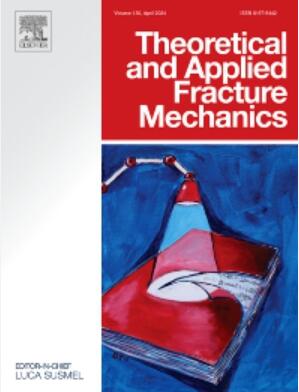Modeling structure-dependent fracture behaviors of anisotropic cracked chevron notched Brazilian disc shale samples: Laboratory scale testing
IF 5.6
2区 工程技术
Q1 ENGINEERING, MECHANICAL
引用次数: 0
Abstract
The anisotropic fracture behaviors of layered shales affect the exploration and development of shale gas resources. Extensive investigations have been devoted to revealing the anisotropic geomechanically behaviors of intact or flawed shale under various loading paths. However, the structure-dependent fracture behavior and fracture toughness of layered shale were not well understood. The presented studies aim to conduct static fracture mechanical testing on cracked chevron notched Brazilian disc shale samples with different bedding inclinations (θ) and different crack angles (β), to reveal the influence of layer angle and crack angle on its fracture behaviors. The mechanical properties, energy conversion, fracture toughness and macro-meson fracture characteristics are studied, as well as the applicability of the conventional and generalized fracture criterion in layered rock mass is discussed. The results show that (i) The peak loads and fracture energy both increase with the increase of θ, but they increase first and then decrease with the increase of β. (ii) All samples exhibit six different failure modes corresponding to different morphological characteristics at crack surfaces. (iii) The fracture toughness of the samples increases with the increase of θ, and the mode Ⅱ fracture toughness (KⅡC) is about twice that of the mode Ⅰ fracture toughness (KⅠC) under the same θ. The traditional maximum tangential stress (MTS) criterion predicts pure mode II fracture initiation angle (φ0Ⅱ) and KⅡC of the samples with a large error, but the generalized MTS criterion, which considers the T-stresses, has an error in predicting φ0Ⅱ, but it can accurately predict KⅡC.

各向异性裂缝巴西盘状页岩样品的结构依赖破裂行为建模:实验室规模测试
层状页岩的各向异性裂缝行为影响着页岩气资源的勘探与开发。为了揭示完整或有缺陷页岩在不同加载路径下的各向异性地质力学行为,人们进行了大量的研究。然而,层状页岩的断裂行为和断裂韧性的结构依赖性还没有得到很好的认识。本文旨在对不同层理倾角(θ)和不同裂缝角度(β)的裂隙型巴西盘状页岩试样进行静态断裂力学试验,揭示层理角度和裂缝角度对其断裂行为的影响。研究了层状岩体的力学性能、能量转换、断裂韧性和宏观介子断裂特征,讨论了常规断裂准则和广义断裂准则在层状岩体中的适用性。结果表明:(1)峰值载荷和断裂能均随θ的增大而增大,但随β的增大先增大后减小;(ii)所有试样均表现出六种不同的破坏模式,对应于裂纹表面不同的形态特征。(iii)试样的断裂韧性随θ的增大而增大,相同θ下的Ⅱ型断裂韧性(KⅡC)约为Ⅰ型断裂韧性(KⅠC)的2倍。传统的最大切向应力(MTS)判据预测试样的纯II型破裂起裂角(φ0Ⅱ)和KⅡC误差较大,而考虑t应力的广义MTS判据预测φ0Ⅱ存在误差,但能准确预测KⅡC。
本文章由计算机程序翻译,如有差异,请以英文原文为准。
求助全文
约1分钟内获得全文
求助全文
来源期刊

Theoretical and Applied Fracture Mechanics
工程技术-工程:机械
CiteScore
8.40
自引率
18.90%
发文量
435
审稿时长
37 days
期刊介绍:
Theoretical and Applied Fracture Mechanics'' aims & scopes have been re-designed to cover both the theoretical, applied, and numerical aspects associated with those cracking related phenomena taking place, at a micro-, meso-, and macroscopic level, in materials/components/structures of any kind.
The journal aims to cover the cracking/mechanical behaviour of materials/components/structures in those situations involving both time-independent and time-dependent system of external forces/moments (such as, for instance, quasi-static, impulsive, impact, blasting, creep, contact, and fatigue loading). Since, under the above circumstances, the mechanical behaviour of cracked materials/components/structures is also affected by the environmental conditions, the journal would consider also those theoretical/experimental research works investigating the effect of external variables such as, for instance, the effect of corrosive environments as well as of high/low-temperature.
 求助内容:
求助内容: 应助结果提醒方式:
应助结果提醒方式:


